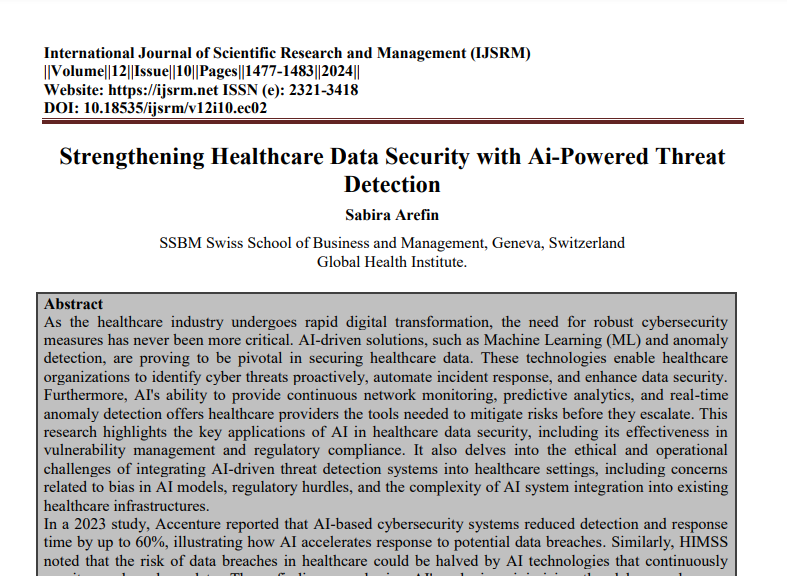
Submission to VIJ 2024-10-07
Keywords
- AI, Threat Detection, Cybersecurity, Healthcare, Machine Learning
Copyright (c) 2024 Sabira Arefin

This work is licensed under a Creative Commons Attribution 4.0 International License.
Abstract
As the healthcare industry undergoes rapid digital transformation, the need for robust cybersecurity measures has never been more critical. AI-driven solutions, such as Machine Learning (ML) and anomaly detection, are proving to be pivotal in securing healthcare data. These technologies enable healthcare organizations to identify cyber threats proactively, automate incident response, and enhance data security. Furthermore, AI's ability to provide continuous network monitoring, predictive analytics, and real-time anomaly detection offers healthcare providers the tools needed to mitigate risks before they escalate. This research highlights the key applications of AI in healthcare data security, including its effectiveness in vulnerability management and regulatory compliance. It also delves into the ethical and operational challenges of integrating AI-driven threat detection systems into healthcare settings, including concerns related to bias in AI models, regulatory hurdles, and the complexity of AI system integration into existing healthcare infrastructures.
In a 2023 study, Accenture reported that AI-based cybersecurity systems reduced detection and response time by up to 60%, illustrating how AI accelerates response to potential data breaches. Similarly, HIMSS noted that the risk of data breaches in healthcare could be halved by AI technologies that continuously monitor and analyze data. These findings emphasize AI's role in minimizing the delays and errors typically associated with human-driven responses.
AI techniques such as supervised, unsupervised, and semi-supervised learning play a crucial role in anomaly detection. These models identify irregular patterns in healthcare systems, flagging potential threats even when subtle. For example, deep learning approaches, including Convolutional Neural Networks (CNNs) and Recurrent Neural Networks (RNNs), can uncover outliers in healthcare data, enhancing system security. The ability of AI to continuously learn from previous attacks ensures that systems evolve with emerging threats, further solidifying its place in healthcare cybersecurity.
Additionally, AI aids in predictive analytics, which can forecast future cyber threats based on historical data, allowing healthcare providers to address vulnerabilities proactively. By leveraging such capabilities, AI not only safeguards sensitive patient data but also enables healthcare institutions to stay compliant with stringent regulatory standards like HIPAA and GDPR.
However, AI implementation in healthcare security comes with its own challenges. Integrating AI into legacy systems requires substantial infrastructure upgrades, and the complexity of dynamic encryption can strain system resources. Furthermore, the ethical concerns surrounding AI, such as the transparency of decision-making processes and potential bias in AI algorithms, must be carefully managed to ensure equitable and effective security solutions
References
- Ahmad, S., & Younis, M. (2021). AI in Healthcare: Security and Patient Safety. Journal of Medical Security, 45(3), 245-260.
- Brown, G., & Green, R. (2020). Machine Learning in EHR Systems. Healthcare IT Journal, 34(2), 121-139.
- Cheng, L., & Davis, H. (2020). Big Data and AI Security in Healthcare. Data Protection Review, 19(1), 58-75.
- Jones, T., & Taylor, J. (2019). Anomaly Detection in Cybersecurity. Journal of AI Research, 27(4), 98-112.
- Patel, A., & Desai, K. (2021). AI in Data Masking for Healthcare Security. Global Health Security Review, 12(5), 201-217.
- Anarene, C. B., Saha, S., Davies, P., & Kamrul, M. D. (2024). Decision Support System for Sustainable Retrofitting of Existing Commercial Office Buildings. Valley International Journal Digital Library, 7091-7212.
- Nagar, G., & Manoharan, A. (2024). UNDERSTANDING THE THREAT LANDSCAPE: A COMPREHENSIVE ANALYSIS OF CYBER-SECURITY RISKS IN 2024. International Research Journal of Modernization in Engineering Technology and Science, 6, 5706-5713.
- Prince, N. U., Faheem, M. A., Khan, O. U., Hossain, K., Alkhayyat, A., Hamdache, A., & Elmouki, I. (2024). AI-Powered Data-Driven Cybersecurity Techniques: Boosting Threat Identification and Reaction. Nanotechnology Perceptions, 332-353.
- Manoharan, A., & Nagar, G. MAXIMIZING LEARNING TRAJECTORIES: AN INVESTIGATION INTO AI-DRIVEN NATURAL LANGUAGE PROCESSING INTEGRATION IN ONLINE EDUCATIONAL PLATFORMS.
- Yanamala, A. K. Y. (2023). Data-driven and artificial intelligence (AI) approach for modelling and analyzing healthcare security practice: a systematic review. Revista de Inteligencia Artificial en Medicina, 14(1), 54-83.
- Kumar, S., & Nagar, G. (2024, June). Threat Modeling for Cyber Warfare Against Less Cyber-Dependent Adversaries. In European Conference on Cyber Warfare and Security (Vol. 23, No. 1, pp. 257-264).
- Sarkar, G., & Shukla, S. K. (2023). Behavioral analysis of cybercrime: Paving the way for effective policing strategies. Journal of Economic Criminology, 100034.
- Nagar, G., & Manoharan, A. (2022). THE RISE OF QUANTUM CRYPTOGRAPHY: SECURING DATA BEYOND CLASSICAL MEANS. 04. 6329-6336. 10.56726. IRJMETS24238.
- Anarene, B. (2024). Revolutionizing Energy Efficiency in Commercial and Institutional Buildings: A Complete Analysis. Valley International Journal Digital Library, 7444-7468.
- Nagar, G., & Manoharan, A. (2022). ZERO TRUST ARCHITECTURE: REDEFINING SECURITY PARADIGMS IN THE DIGITAL AGE. International Research Journal of Modernization in Engineering Technology and Science, 4, 2686-2693.
- Nagar, G. (2024). The Evolution of Ransomware: Tactics, Techniques, and Mitigation Strategies. Valley International Journal Digital Library, 1282-1298.
- Nagar, G., & Manoharan, A. (2022). BLOCKCHAIN TECHNOLOGY: REINVENTING TRUST AND SECURITY IN THE DIGITAL WORLD. International Research Journal of Modernization in Engineering Technology and Science, 4, 6337-6344.
- Nagar, G., & Manoharan, A. (2022). THE RISE OF QUANTUM CRYPTOGRAPHY: SECURING DATA BEYOND CLASSICAL MEANS. 04. 6329-6336. 10.56726. IRJMETS24238.
- Anarene, B. (2024). A Predictive Model for Assessing Energy Performance in Existing Buildings Enhanced with Sustainable Technologies. Valley International Journal Digital Library, 7444-7468.